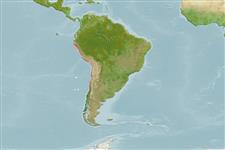Common names from other countries
Environment: milieu / climate zone / depth range / distribution range
Écologie
marin démersal. Tropical; 5°S - 37°S, 82°W - 70°W
Southeast Pacific: reported from the warm temperate waters of the west coast of South America; from Callao, Peru (12° 02'S) to Talcahuano, Chile (36°41'S).
Taille / Poids / Âge
Maturity: Lm ? range ? - ? cm
Max length : 43.7 cm TL mâle / non sexé; (Ref. 95867); poids max. publié: 862.00 g (Ref. 53696)
Description synthétique
Clés d'identification | Morphologie | Morphométrie
Épines dorsales (Total) : 16 - 17; Rayons mous dorsaux (Total) : 18 - 21; Épines anales: 3; Rayons mous anaux: 6 - 9; Vertèbres: 34 - 35.
This species is most abundant littoral species on the coast of central Chile, found in close association with the brown kelp Lessonia trabeculata. Juveniles found in tidepools to a maximum size of 15.7 cm TL and an estimated 3 years of age, adults occur subtidally. It is mainly herbivorous, feeding almost exclusively on brown, red and green algae, with a strong preference for green and red algae (digestion by acid hydrolysis). Its meat reported as an excellent pan-fish, with rich, white, sweet, and flaky meat (Ref. 86913).
Life cycle and mating behavior
Maturities | Reproduction | Spawnings | Egg(s) | Fecundities | Larves
Russell, B.C., 2000. Review of the southern temperate fish family Aplodactylidae (Pisces: Perciformes). J. Nat. Hist. 34(1):2157-2171. (Ref. 86913)
Statut dans la liste rouge de l'IUCN (Ref. 130435)
CITES (Ref. 128078)
Not Evaluated
Menace pour l'homme
Harmless
Utilisations par l'homme
Pêcheries: sans intérêt
Outils
Articles particuliers
Télécharger en XML
Sources Internet
Estimates based on models
Preferred temperature (Ref.
115969): 12.8 - 23.7, mean 19.5 (based on 165 cells).
Phylogenetic diversity index (Ref.
82804): PD
50 = 0.5625 [Uniqueness, from 0.5 = low to 2.0 = high].
Bayesian length-weight: a=0.00603 (0.00287 - 0.01263), b=3.14 (2.94 - 3.34), in cm Total Length, based on LWR estimates for this species & (Sub)family-body (Ref.
93245).
Niveau trophique (Ref.
69278): 2.0 ±0.0 se; based on diet studies.
Fishing Vulnerability (Ref.
59153): Low to moderate vulnerability (34 of 100).
